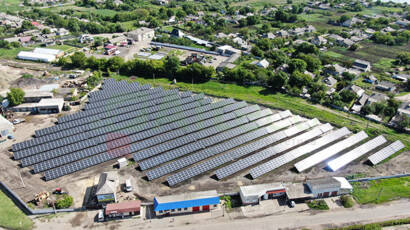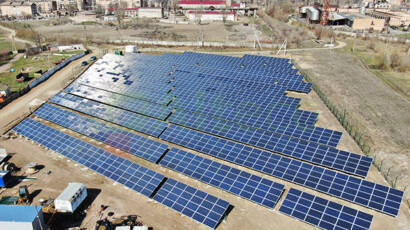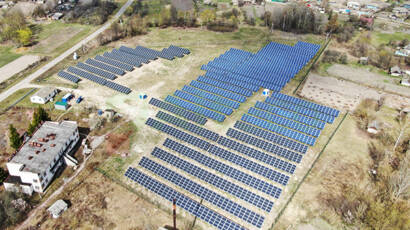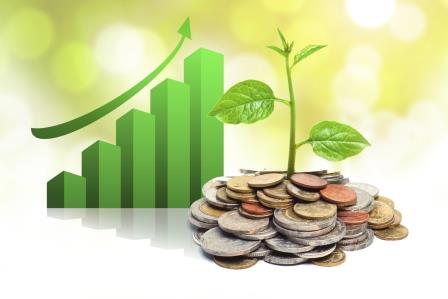 With rising energy prices, people are increasingly turning their attention to energy-saving equipment.Unfortunately, its cost often forcesmany potential customers to postpone the purchase, but from 20.07.2015 there is an opportunity to significantly offset these costs and in a few years to make a profit, even in private households.
With rising energy prices, people are increasingly turning their attention to energy-saving equipment.Unfortunately, its cost often forcesmany potential customers to postpone the purchase, but from 20.07.2015 there is an opportunity to significantly offset these costs and in a few years to make a profit, even in private households.
Legal basis of the “green” tariff for private households
According to the last adopted Law of Ukraine №514-VIII dated 04.06.2015 “On amendments to certain laws of Ukraine on ensuring competitive conditions of electricity production from alternative energy sources” and Resolution of the National Commission for Electricity Market Regulation №725 dated 25.03.2020 “On establishing “green “tariffs for electricity for private households”, the following rates of “green” tariff are accepted:
Green tariff rates during the commissioning of SPP and WPP, without VAT
| Type of station | to 31.12.2019 | from 01.01.2020 to 31.12.2020 | from 01.01.2021 to 31.12.2021 | from 01.01.2022 to 31.12.2022 | from 01.01.2023 to 31.12.2024 | from 01.01.2025 to 31.12.2029 |
| Private SPP | 0,181Euro per kWh | 0,163Euro per kWh | 0,163Euro per kWh | 0,163 Euro per kWh | 0,163 Euro per kWh | 0,145Euro per kWh |
| Private WPP | 0,116Euro per kWh | 0,104Euro per kWh | 0,104Euro per kWh | 0,104Euro per kWh | 0,104Euro per kWh | 0,093 Euro per kWh |
You can see the difference in tariffs for solar and wind stations. This practice is widespread in the world and is associated with modern technical development of each of the areas of alternative energy (sun, wind, bio, hydro).
You can also see a gradual reduction in the rate of “green” tariff depending on the year of commissioning. This approach is designed to take into account the global trend to reduce the cost of alternative energy equipment and the total cost of equipping stations, as well as the gradual increase in conventional tariffs.This means that in about 10 years, the cost of energy from nuclear, coal and gas power plants will be equal in value to energy from alternative sources. As a result, the need for a “green” tariff will disappear by itself.

How does it work?
In the case of placing a solar or wind power plant in a private household – it is connected to the network at home and to the “general network” through a special (bidirectional) node for metering and production of electricity.This node takes into account the electricity produced and consumed by the household for the whole month.
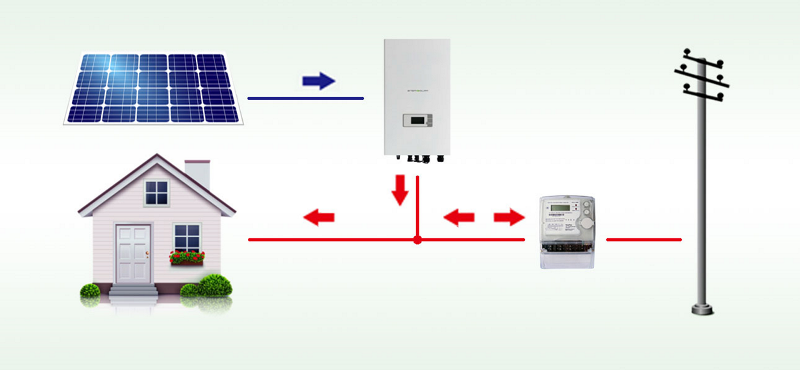
Image: Connection scheme of home grid SPP
If more electricity is generated than it consumes, the local grid is obliged to pay the difference (ie not all produced), regardless of its volume, at the rate of “green” tariff. If consumption exceeds production – the consumer pays the difference (not all consumed), at the rate set for the population in the area.
Actually, the meter can “rotate” in both directions during the month, and electricity is accounted for as a result of “overflows” at the end of each month.For example, a solar / wind power plant generated 1000 kWh of electricity.Of these, 200 kWh consumed themselves, 800kWh sold in the network, so we will receive payment only for 800 kWh.
Homeowners do not need permits to install solar panels.No licenses (similar to those required by energy facilities) for the sale of electricity generated by the network, for a private household, are also required.All you need to do is mount the station and submit the relevant documents to the Distribution electric networks (connection diagram, equipment passports and certificates of conformity).
It is necessary to considerthat the capacity of the station should not exceed the connected to the household connection capacity according to the technical conditions and the contract.To increase capacity – it is necessary to submit an application to Distribution electric networks (Oblenergo) for capacity increase (paid by the Customer) and go through the standard registration procedure.
How much is a solar station?
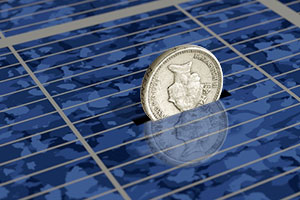 The average cost of a turnkey solar station is from $ 5,000 (5 kW) to $ 20,000 (30 kW), or from $ 1 to $ 0.65 per 1 watt of installed power.But, in order to correctly answer this question and understand what power station we need, it is necessary to determine the monthly electricity consumption of the household.We must remember that the task – to calculate a station of greater capacity – to produce excess energy, which we will sell.
The average cost of a turnkey solar station is from $ 5,000 (5 kW) to $ 20,000 (30 kW), or from $ 1 to $ 0.65 per 1 watt of installed power.But, in order to correctly answer this question and understand what power station we need, it is necessary to determine the monthly electricity consumption of the household.We must remember that the task – to calculate a station of greater capacity – to produce excess energy, which we will sell.
For example, the average private house equipped with common appliances (refrigerator, washing machine, vacuum cleaner, TV, etc.) usually has a monthly power consumption of 150 to 250 kWh per month or 5-8.3 kWh per day.
For further calculation, we take the average figure of own consumption: 200 kWh per month.
For a solar station we will accept power: 30 kW (for example 90 panels on 340 W).
Location: Kyiv region.
The minimum of solar energy is observed – in winter, the maximum – in summer.
Solar power plant with a capacity of 30 kW:
– in December (minimum productivity) will give about 800 kWh per month;
– in the summer months (from March to September – maximum productivity), on average about 3 500 kWh per month;
– per year the station will produce about 34 200 kWh.
In view ofthe annual consumption of the house 200 kWh per month. x 12 months = 2400 kWh, we have overproduction at the level of 31 800 kWh, which at the rate of 4.60 UAH / kWh (by the end of 2024) will be 146,280 UAH of annual income, accordingly.Or in the equivalent of USD at the rate of 27 UAH. for 1 USD = 5 418 USD per year (on the date of writing the article).
It is necessary to consider that from the received moneyit will be necessary to pay taxes (VAT + military duty) = 19.5%.In our case it is 5 418 USD x 19.5% = 1 057 USD.Thus, the “net” profit from sales is: 5 418 USD – 1 057 USD = 4 280 USD.
We also do not forget about the energy we consumed, it is 2400 kWh x 1.68 UAH per kWh (excluding future increases) = 4 032 UAH. / rate 27 = 149 USD per year.
Total net income will be: 4 280 USD + 149 USD = 4 429 USD per year.
The cost of a network solar station with a capacity of 30 kW “turnkey” with a “green” tariff, will be about 20 000 USD (see the typical calculation here).
Thus, the payback period will be: 20 000 USD / 4 429 USD = approximately 4.5 years.
The service life of the solar station is more than 20 years (manufacturers are guaranteed a reduction in the productivity of photovoltaic modules by no more than 20% for 25 years due to the degradation effect).The solution is to install additional PV modules in 20-25 years to compensate for these losses.
Also, the payback period can be reduced by many engineering tricks.Such as: professional 3-d modeling of panel placement, application of Bifacial technology, correct selection of cable cross-sections, high-quality installation and constant On-line monitoring of the station with adjustment of the system to the necessary ranges of work if necessary.
Another good news is that the legislatively “green” tariff for private households, as well as for legal entities, is tied to the EURO exchange rate.This means that with serious fluctuations in the foreign exchange market, the cost of the “green” tariff for individuals will also change.This will be an additional guarantee of investment in this equipment.
When deciding on the installation of a solar power plant, the following should be taken into account:
- the presence of a site (roof, facade of the building), suitable for the optimal mode of operation of the station (good lighting during the day, orientation to the south).Sufficient area for installation of PV modules.For example, a station with a capacity of 10 kW will cover an area of about 50 square meters. sloping roof;
- connection point capacity and direct contract with Distribution electric networks (Oblenergo).If there is a lack of power – go through the procedure of its increase.When you are part of a cooperative – reconnect directly toDistribution electric networks (Oblenergo);
- equipment selection. All equipment must be certified in accordance with current legislation of Ukraine, have a passport and operating instructions.Now, most of the Western manufacturers (including well-known companies) produce their products in the Chinese factories.At the same time, the quality of equipment made in China is at a very high level. Therefore, at the stage of equipment selection you need to understand where to go in case of equipment failure, for example, after 5 years.
How to connect?
The connection of the solar / wind station of a private household (individuals) is carried out according to a simplified procedure. This requires:
- Install the station.
- Write an application in the Distribution electric networks to connect the station (a sample application is available in the Distribution electric networks) and provide a connection diagram (make yourself or ask the installation company).
- Based on the application, Distribution electric networks conducts OTM (Organizational and technical measures), namely: installation of a bidirectional meter with a modem (metering unit), their installation and connection.The service is performed by Distribution electric networks employees or authorized persons.Paid by the customer (household) and today is (on average) 10-12 thousand UAH.
- After the OTM, a representative of Oblenergo arrives at the site, inspects the station and concludes an agreement on the purchase and sale of electricity between Oblenergo and the household owner.The current account to which the money will be received is specified in the contract (it should be opened in advance). Oblenergo has no requirements for the bank.
In our experience, the time of registration of such stations today takes – 1-1.5 months.
About the payback period and operation of SPP
Currently, there is a favorable situation for the installation of solar power plants, energy-saving equipment and smart owners are now actively installing them.But the efficiency of this equipment, reliability and payback period, directly depend on the correct calculations and selected components.
Very often, “experts” even with very good materials manage to make a lot of blunders and to nullify all hopes of the Customer.Moreover, there are things that manifest themselves after 2-3 years of operation and it is impossible to change them.
Funny fact, but in the last few years we have seen more and more facilities where we have installed a station with less capacity – it produces more generation per year than a neighbor with more capacity, installed by other contractors. And the stations are almost nearby.
You ask, how can this be?We answer that in order SPP worked as it is necessary the 20-25 years, you just need to execute only:
1. Professional calculations
2. Choose the right equipment.
3. Perform quality installation.
4. Monitor the station throughout its life.
Alteco specialists have great experience in installing such equipment in both production and private households, we do not stop saying that the more professional the approach of the Customer and the Contractor to the task, the better the result will be for everyone.

